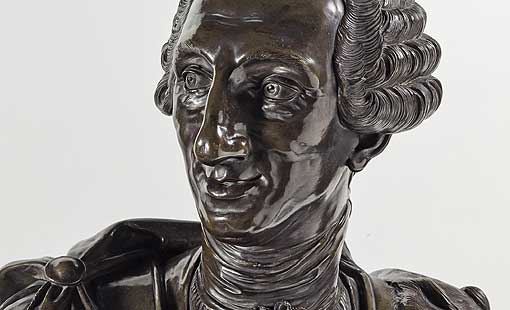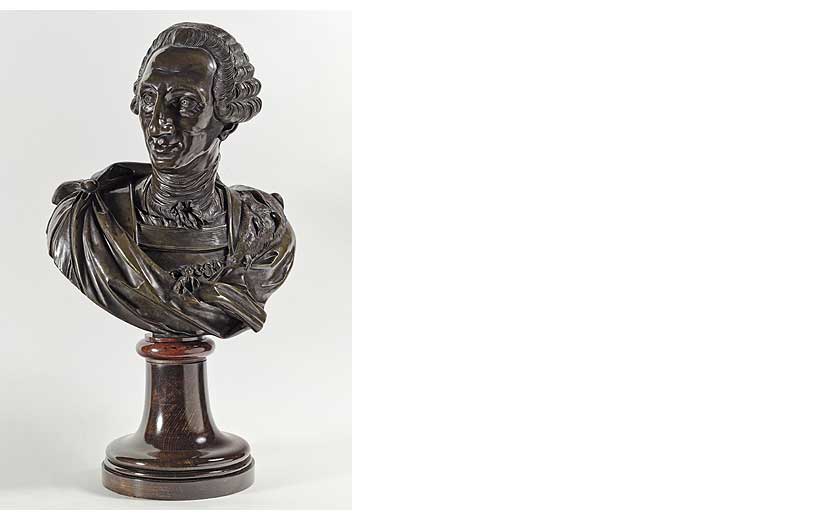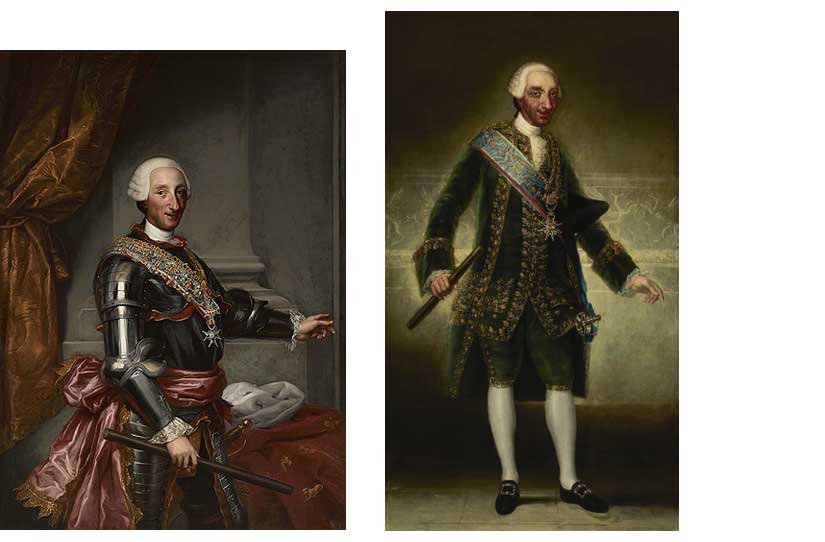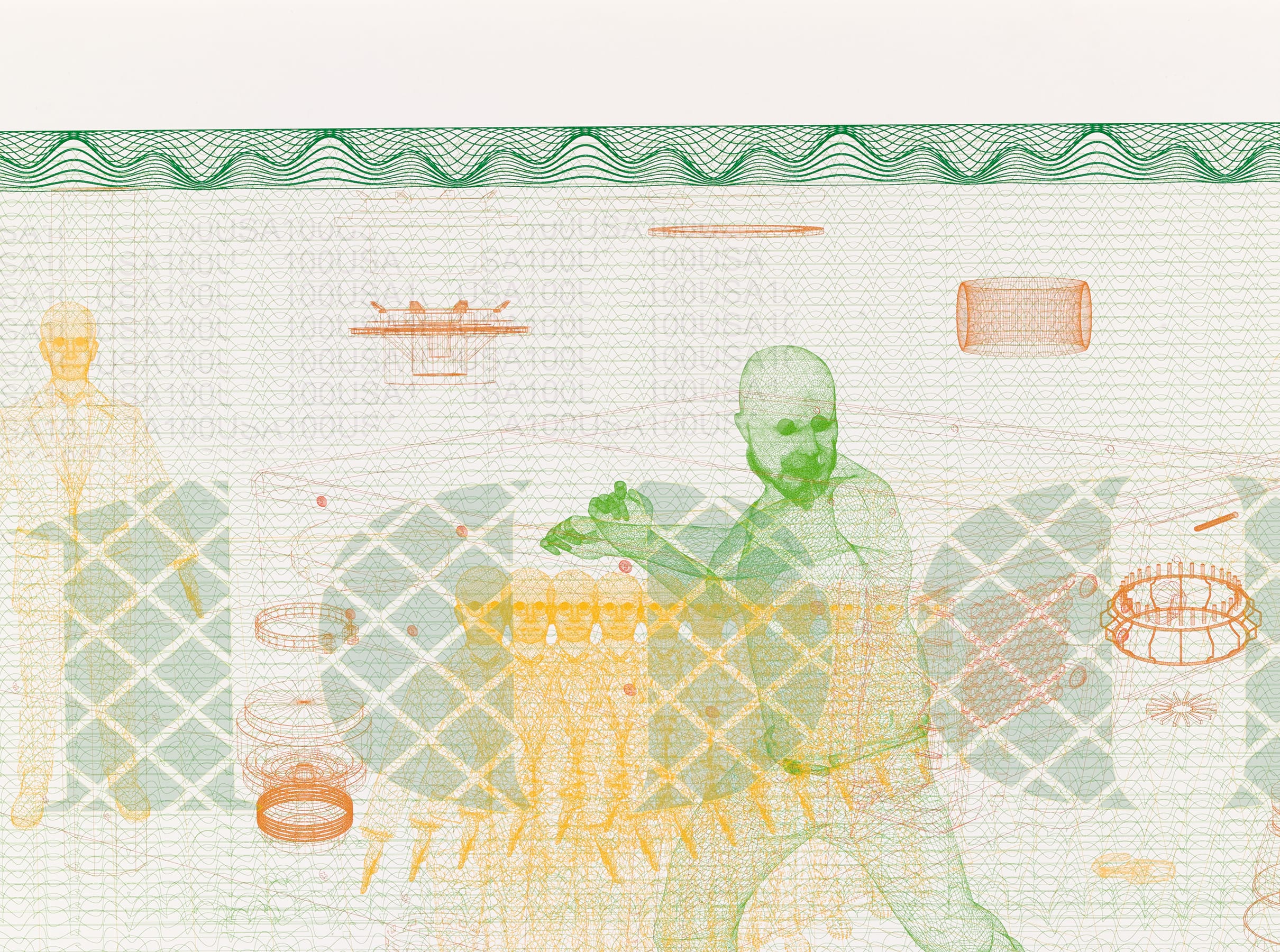
Bust of King Charles III of Spain by Italian sculptor Giacomo Zoffoli, who worked in bronze and specialised in copies of Greek and Roman works
The works in the exhibition 2328 reales de vellón. Goya and the Origins of the Banco de España Collection include this bronze bust of King Charles III of Spain (1716-1788), one of the oldest sculptures in the collection. It was during his reign that the Banco Nacional de San Carlos, considered to be the earliest forerunner of the Banco de España, was founded in 1782. This striking piece is the only sculpture in the exhibition, but its place is well deserved for both its artistic and historic value.
It is the work of Giacomo Zoffoli (c. 1731-1785), a sculptor who worked in Rome in the second half of the 18th century, where he and his brother Giovanni (1745-1805) ran a foundry that specialised in bronze reproductions of renowned art works. Isabel Tejeda explains that the Zoffoli brothers made a substantial fortune from producing small-format bronze copies of major Greek and Roman works in the city's collections, and of works found in the digs at Pompeii and Herculaneum.
 Giacomo Zoffoli: 'Charles III, King of Spain' (1781)
Giacomo Zoffoli: 'Charles III, King of Spain' (1781)
Along with orders for copies of ancient sculptures, their workshop on what is now the Via Sistina in Rome also accepted other commissions, among them this bust of Charles III, which dates from 1781. For some time, it was thought to be of his son Ferdinand of Bourbon and Saxony (1751-1825), King of the Two Sicilies. However, as pointed out by Pablo Vázquez Gestal, the resemblance to numerous paintings of Charles III by Anton Rafael Mengs![]() (1728-1779), especially the portrait in oils in the Azara Collection, is clear evidence that he is the subject of the bust. Indeed, the facial features of the two works are so similar that Zoffoli may well have taken the painting by Mengs, which was owned by José Nicolas de Azara
(1728-1779), especially the portrait in oils in the Azara Collection, is clear evidence that he is the subject of the bust. Indeed, the facial features of the two works are so similar that Zoffoli may well have taken the painting by Mengs, which was owned by José Nicolas de Azara![]() (1730-1804), who was working in Rome as Agent General of the King of Spain in 1781, as his model for the bust.
(1730-1804), who was working in Rome as Agent General of the King of Spain in 1781, as his model for the bust.
Further evidence that the bust is of Charles III can be found in the biography of the king by the 6th Count of Fernán Núñez![]() (1742-1795). The count writes that he acquired a bust of the king made in Rome and had a pedestal built for it with four inscriptions, one of which indicated that the bust was made by Giacomo Zofolli in 1781. Vázquez Gestal states that all the evidence indicates that the bust owned by the Count of Fernán Núñez was either the one now held at the Banco de España or perhaps a copy of it that has since been lost. Curiously, the bust by Zoffoli appears in a portrait of Marquis Pierre-Paul d’Ossun
(1742-1795). The count writes that he acquired a bust of the king made in Rome and had a pedestal built for it with four inscriptions, one of which indicated that the bust was made by Giacomo Zofolli in 1781. Vázquez Gestal states that all the evidence indicates that the bust owned by the Count of Fernán Núñez was either the one now held at the Banco de España or perhaps a copy of it that has since been lost. Curiously, the bust by Zoffoli appears in a portrait of Marquis Pierre-Paul d’Ossun![]() (1713-1788), France's Ambassador to the Two Sicilies (1752-1759) and to Spain (1759-1777). That portrait is attributed to César van Loo and is currently held by the National Gallery of Art in Washington
(1713-1788), France's Ambassador to the Two Sicilies (1752-1759) and to Spain (1759-1777). That portrait is attributed to César van Loo and is currently held by the National Gallery of Art in Washington![]() .
.
 (Studio of ) Mariano Salvador Maella: 'Charles III in Armour' (1783) | Francisco de Goya y Lucientes: 'King Charles III' (1786)
(Studio of ) Mariano Salvador Maella: 'Charles III in Armour' (1783) | Francisco de Goya y Lucientes: 'King Charles III' (1786)
2328 reales de vellón also features two more pictures of Charles III, who is a fundamental figure for the Banco de España because its forerunner the Banco de San Carlos was founded in the latter part of his reign. The exhibition highlights some of the earliest works in our art collection. On the one hand there is the Portrait of Charles III in Armour painted at the studio of Mariano Salvador Maella in 1783, which replicates the official portrait of the king![]() by Anton Rafael Mengs dated 1765 (now owned by the Museo del Prado
by Anton Rafael Mengs dated 1765 (now owned by the Museo del Prado![]() ) . It shows him holding the emblems of the Royal and Distinguished Spanish Order of Charles III, founded in 1771, among other royal symbols. On the other hand there is the first of two portraits of Charles III by Francisco de Goya y Lucientes, who actually met him in person, according to letters written to his childhood friend Martín Zapater in Zaragoza. The work is dated 1786. Manuela Mena states that Goya used Mengs' portrait as his model because its image of the king had become better known than his actual face. However, Goya painted the king very differently in terms of his apparent age and facial expression, and placed him in an allegorical setting with a brightly-lit background that makes him stand out and contains subtle allusions to the nature and specific mission of the Banco de San Carlos, which had commissioned the painting.
) . It shows him holding the emblems of the Royal and Distinguished Spanish Order of Charles III, founded in 1771, among other royal symbols. On the other hand there is the first of two portraits of Charles III by Francisco de Goya y Lucientes, who actually met him in person, according to letters written to his childhood friend Martín Zapater in Zaragoza. The work is dated 1786. Manuela Mena states that Goya used Mengs' portrait as his model because its image of the king had become better known than his actual face. However, Goya painted the king very differently in terms of his apparent age and facial expression, and placed him in an allegorical setting with a brightly-lit background that makes him stand out and contains subtle allusions to the nature and specific mission of the Banco de San Carlos, which had commissioned the painting.
